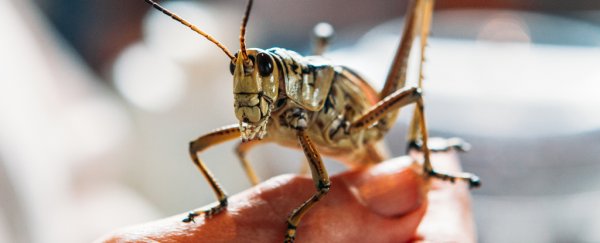Scientists have demonstrated that locusts are adept at differentiating healthy human cells from cancerous cells using their sense of smell – and that could open opportunities for detecting the disease earlier, improving the chances of recovery.
Even better, the insects can actually pick out individual cancer cell lines, suggesting that the type of cancer, as well as the presence of cancer, can be detected.
If we can work out how to harness this ability in medical devices, there's a huge amount of potential.
Published on pre-print website BioRxiv ahead of peer-review, its findings are promising for early cancer detection.
The locust detection, which is measured by changes in their brain activity picked up by electrodes, is shown to be reliable, sensitive, and fast – happening in just a few milliseconds.
"Early detection [of cancer] is so important, and we should use every possible tool to get there, whether it's engineered or provided to us by millions of years of natural selection," says microbiologist Christopher Contag from Michigan State University.
"If we're successful, cancer will be a treatable disease."
This is all made possible because of the volatile organic compounds (VOCs) we breathe out, which scientists know are somehow altered by the presence of cancer interfering with the metabolic processes of individual cells.
The trick is to catch the change early.
Enter the locust, an insect regularly used by scientists in smell research – so we already know a lot about these critters and their olfactory skills.
Using electrodes attached to the locusts' brains, the team was able to measure the insects' response to gas samples from different cells and establish signal profiles that represented the chemicals they were smelling.
Sure enough, the profiles created in response to healthy cells and to cancer cells were distinct.
Having previously established that cells from mouth cancers looked different to normal cells under a microscope, and putting that down to shifts in metabolites, the scientists were able to confirm that the cells did indeed smell different to the locusts – most likely due to the airborne VOCs given off.
This particular study restricted itself to mouth cancers, but the researchers are confident that other types of cancer could be detected in the same way because of the different signatures of the VOCs produced.
"We expected that the cancer cells would appear different than the normal cells. But when the bugs could distinguish three different cancers from each other, that was amazing," says Contag.
Across different types of cancer, the survival rate is around 10-20 percent when the cancer is detected at stage 4 (when it has spread to other parts of the body). Compare that with cancers that are spotted at stage 1, for which patients have an 80-90 percent chance of survival – a huge difference.
Work is already ongoing to develop 'bionic nose' devices that could detect shifts in VOCs, but scientists are still some way short of creating sensors that match up to what nature has created. This discovery potentially offers another way forward in that research.
The ultimate aim of the team is to 'hack' the insect brain in order to use it for disease diagnosis, reverse engineering the natural sniffing power of the locusts. It's still early days, but the researchers can see a path toward usable detection devices.
"Theoretically, you could breathe through a device, and it would be able to detect and differentiate multiple cancer types and even which stage the disease is in," says biomedical engineer Debajit Saha from Michigan State University.
"However, such a device isn't yet close to being used in a clinical setting."
The pre-print paper on the research is available at BioRxiv.
